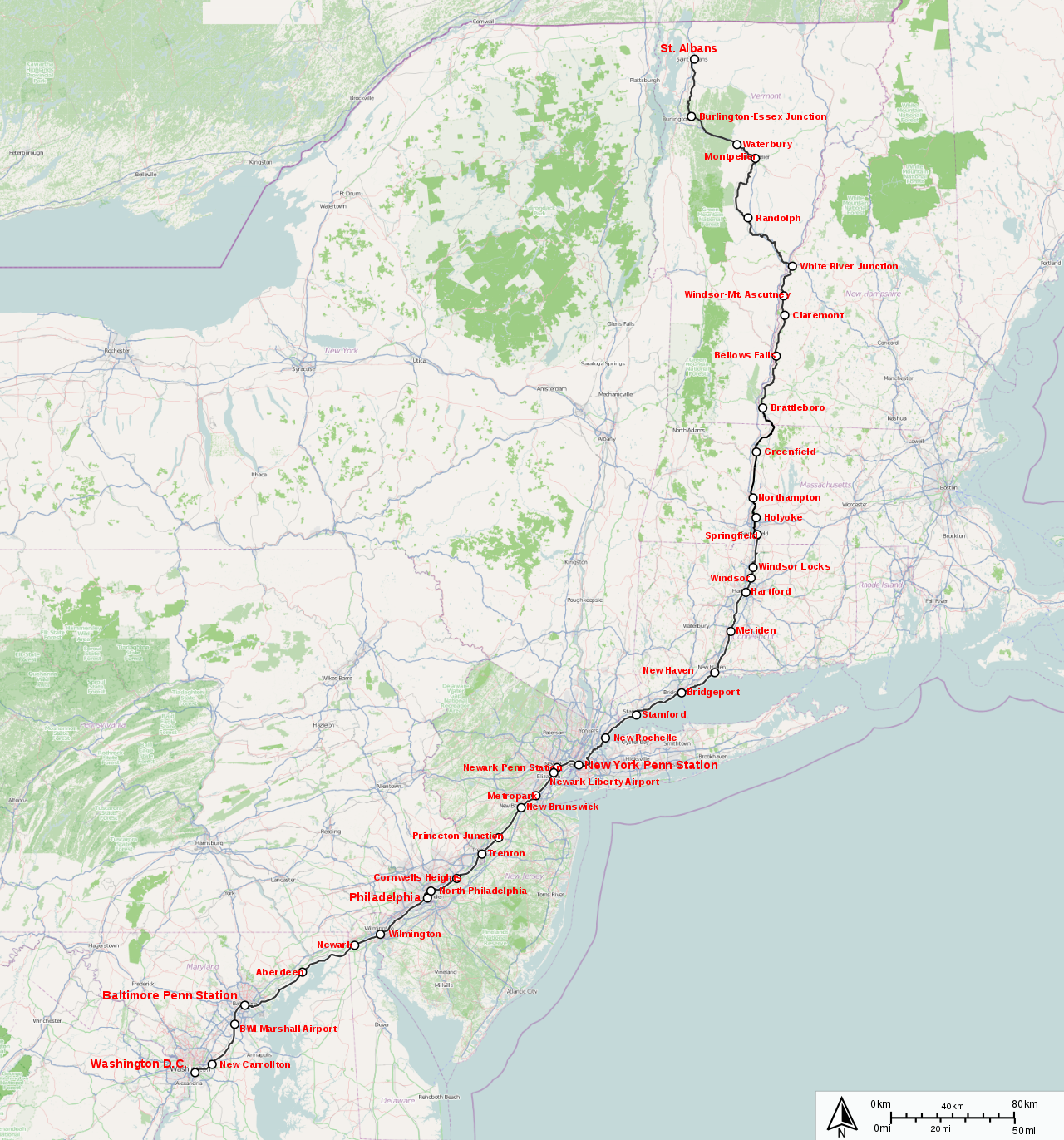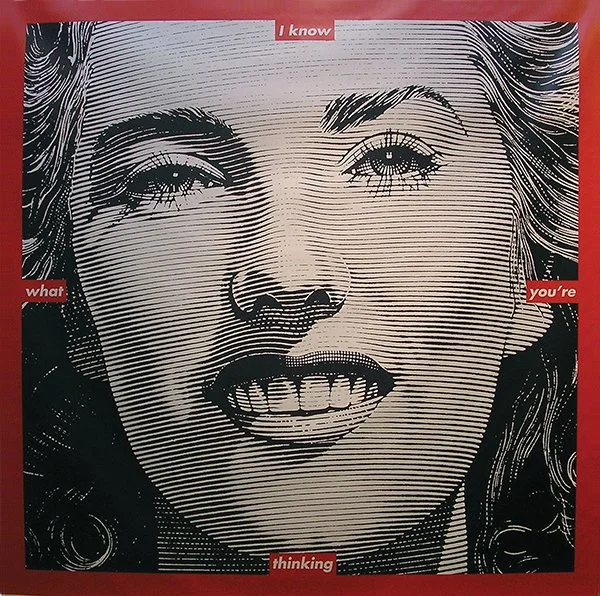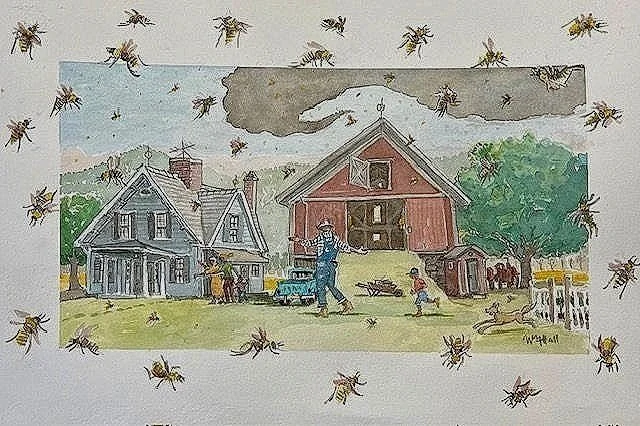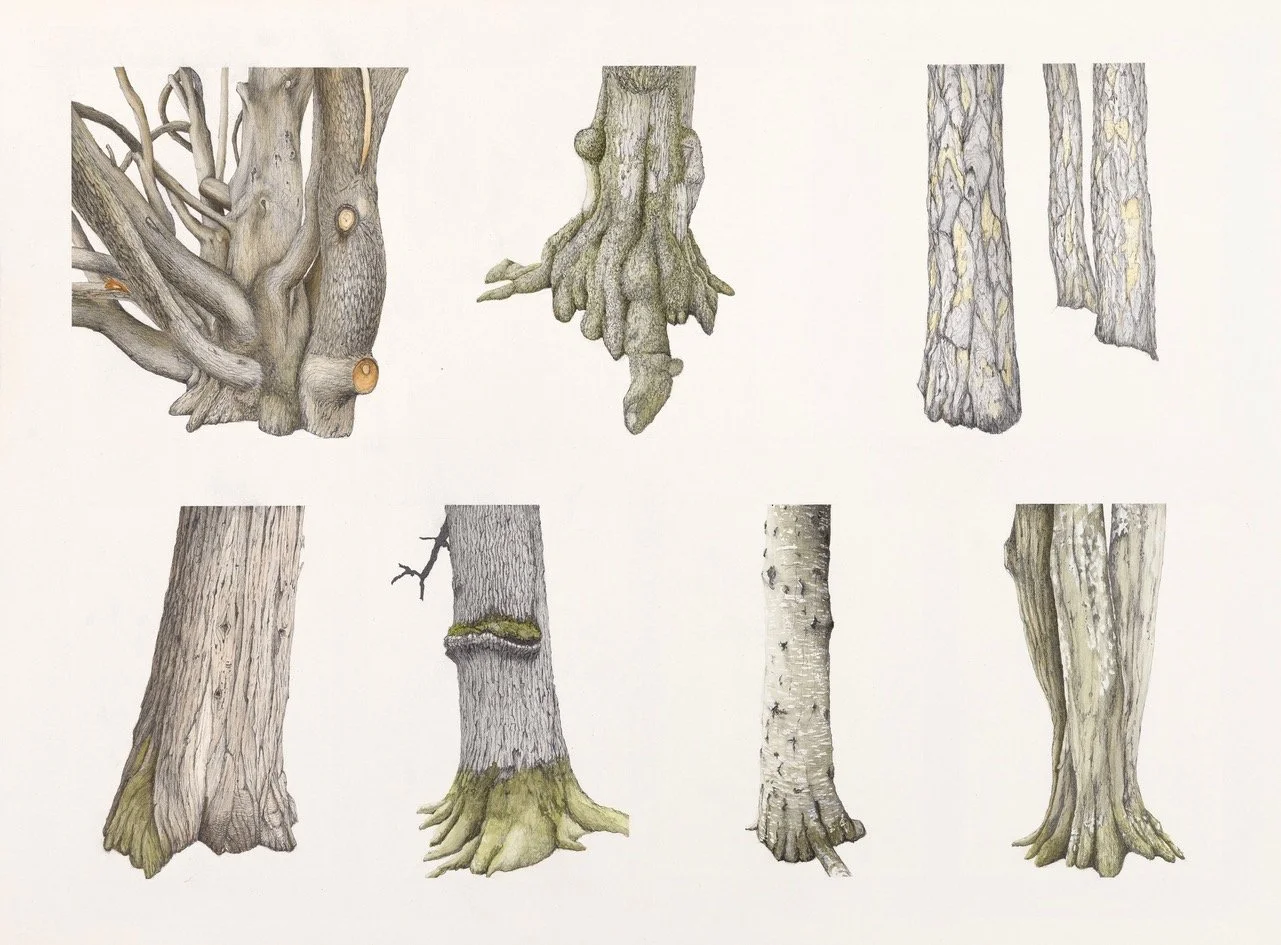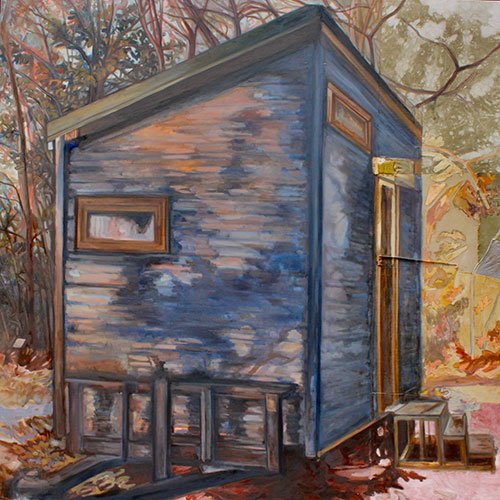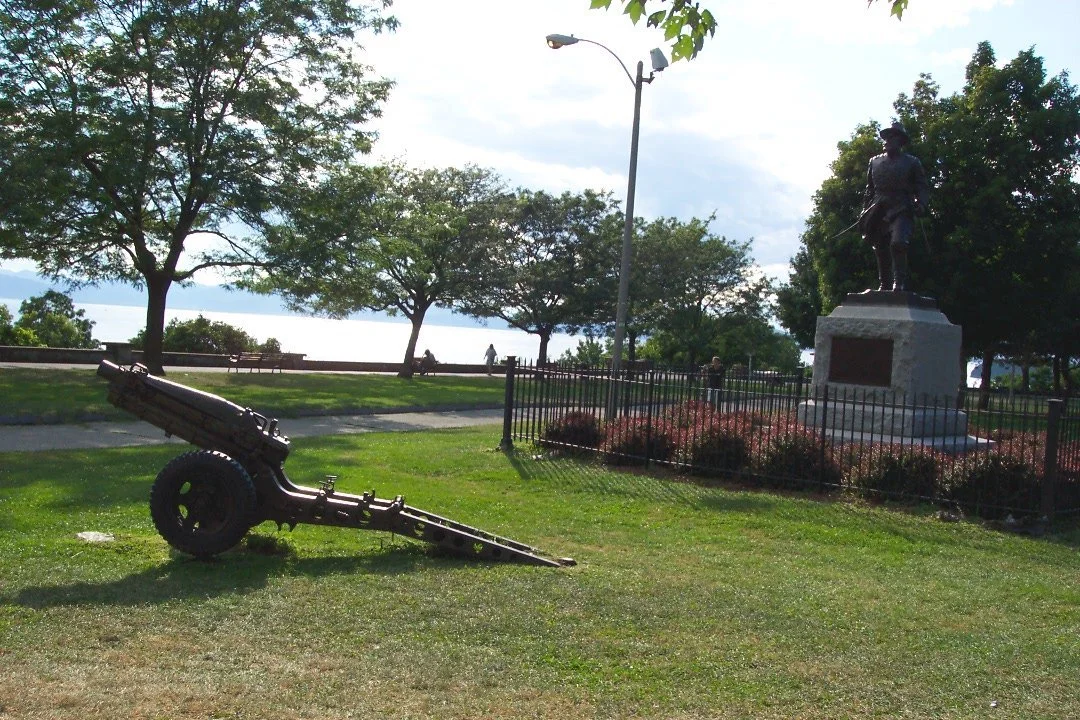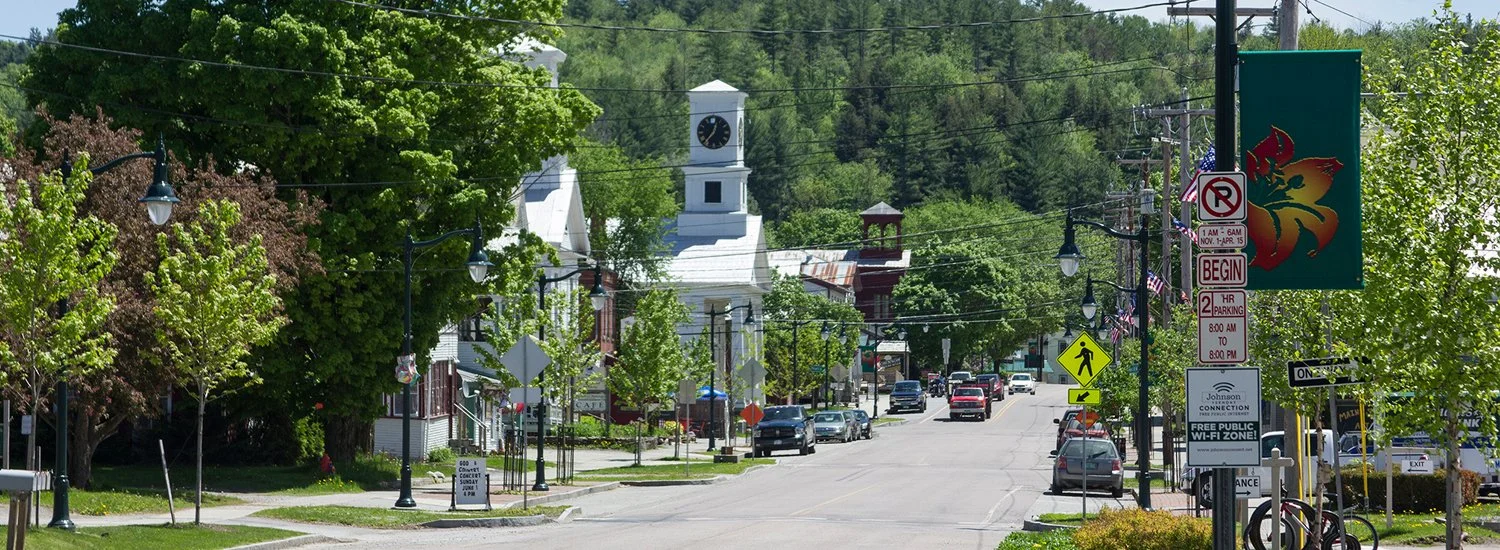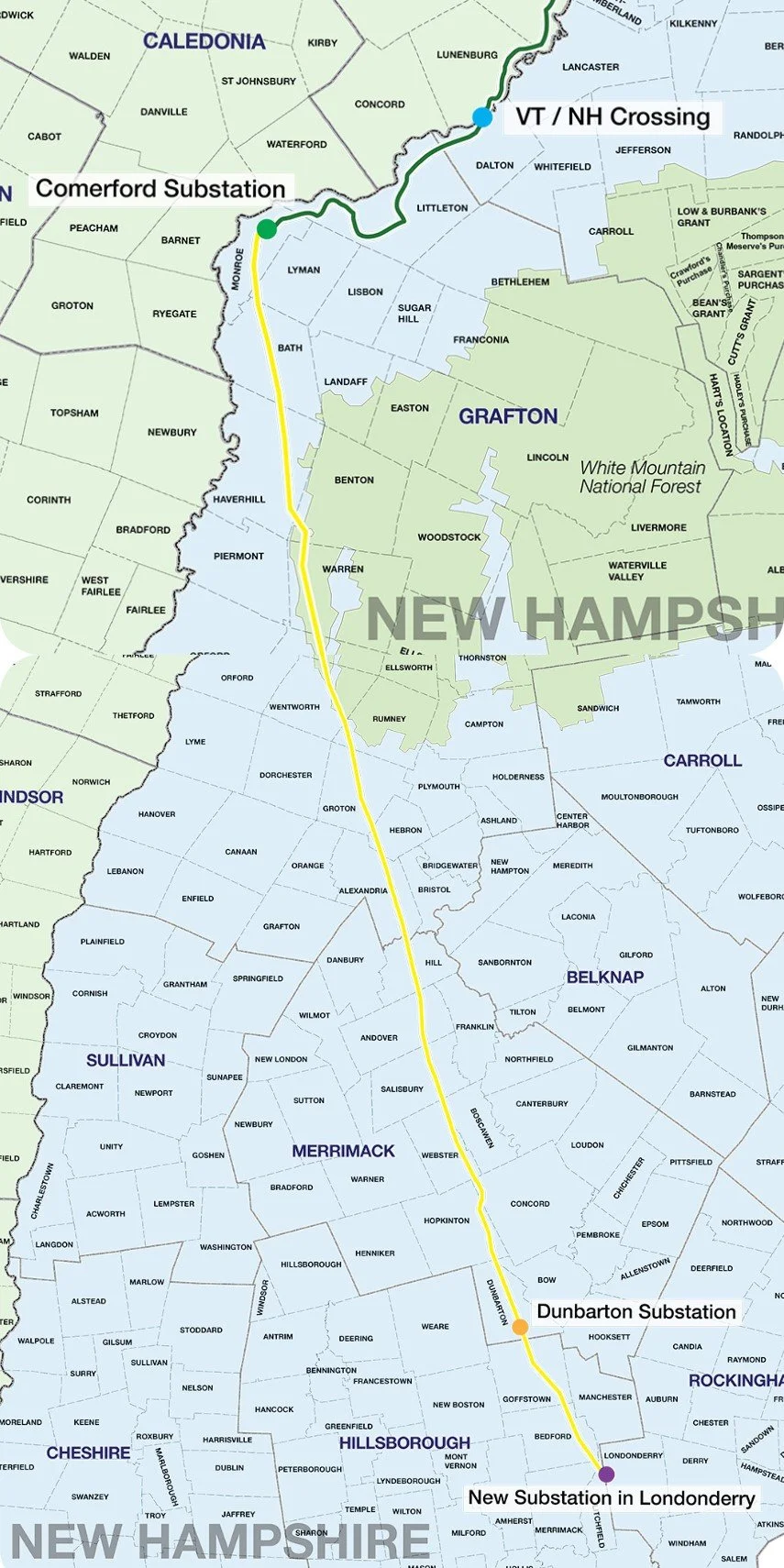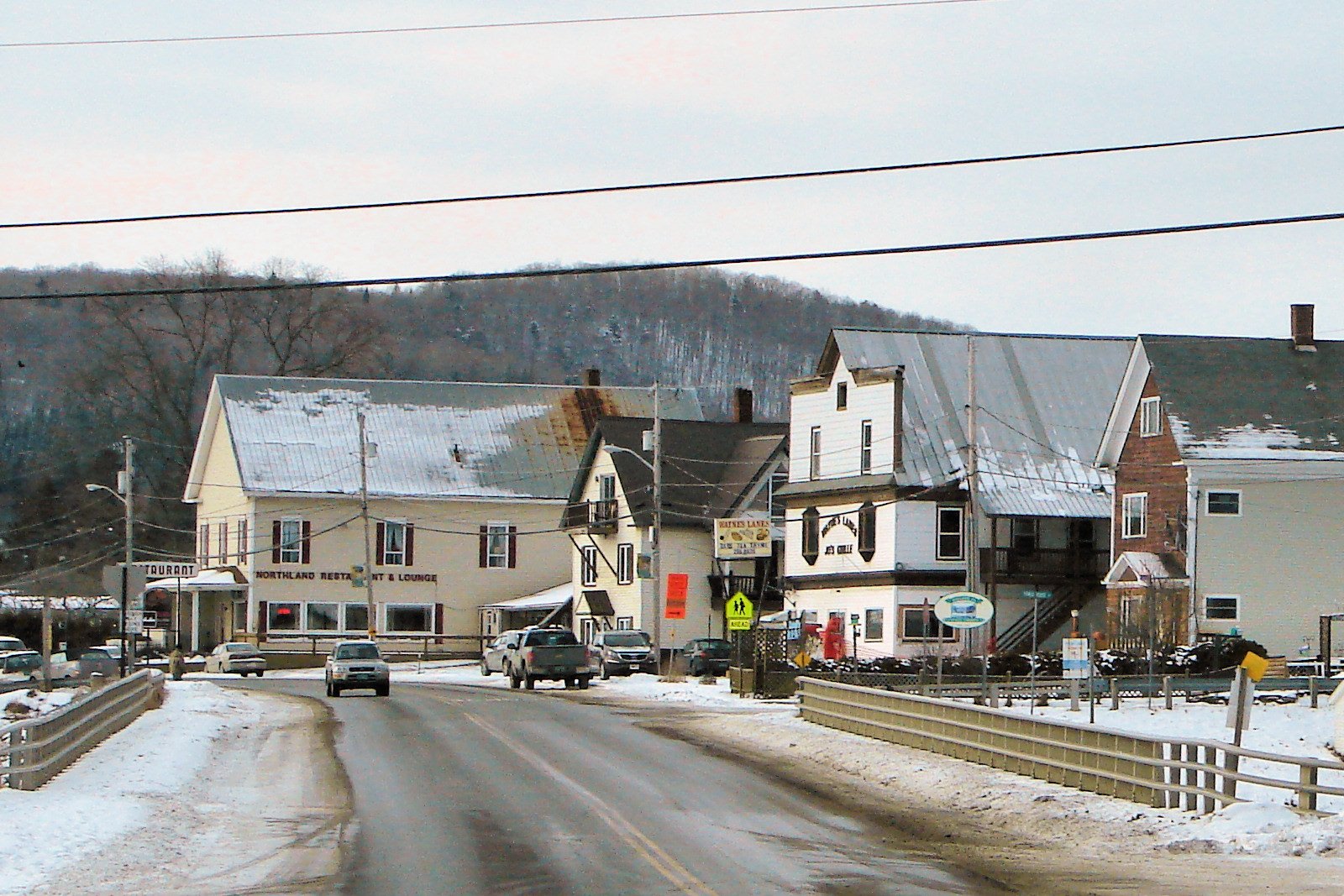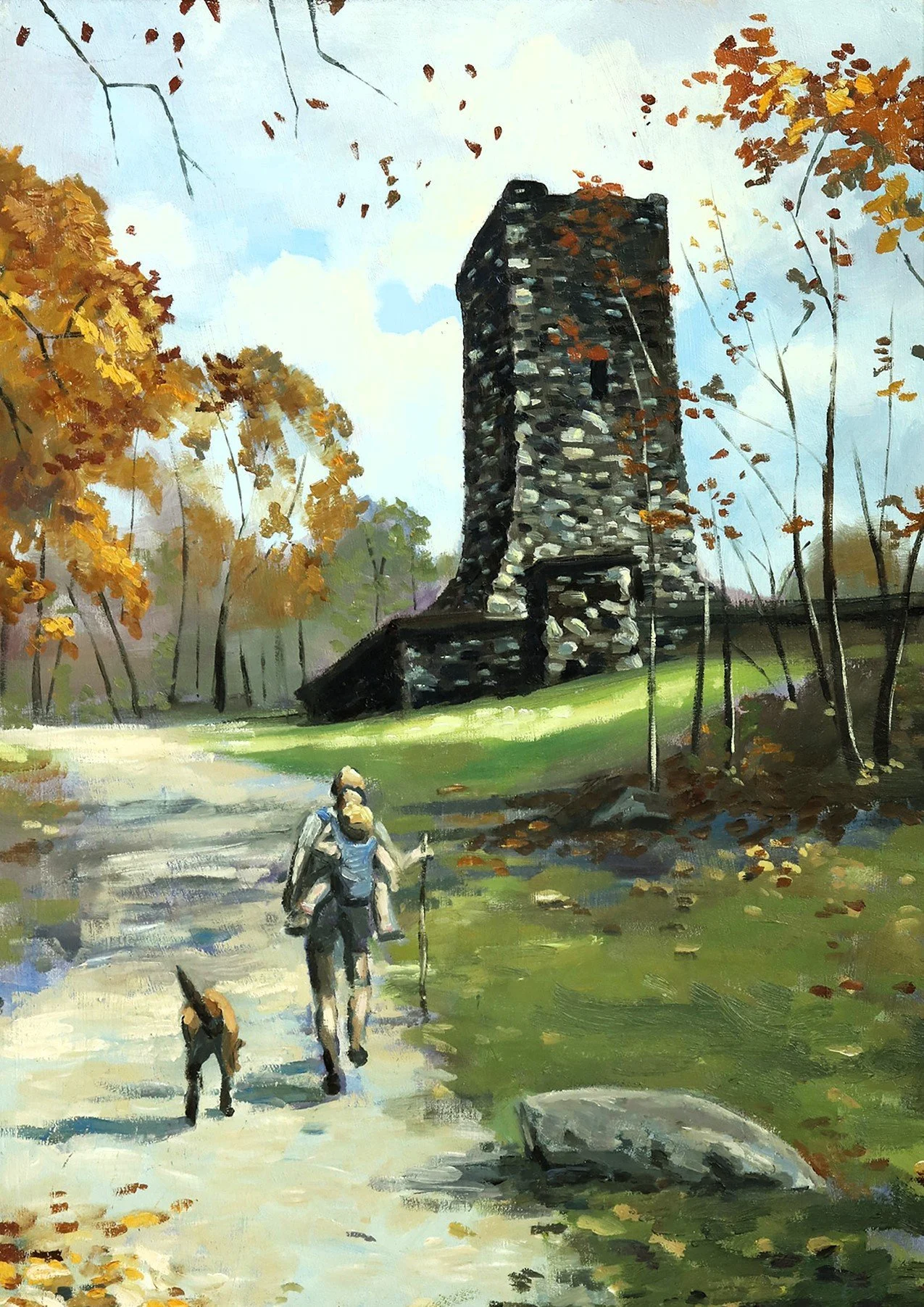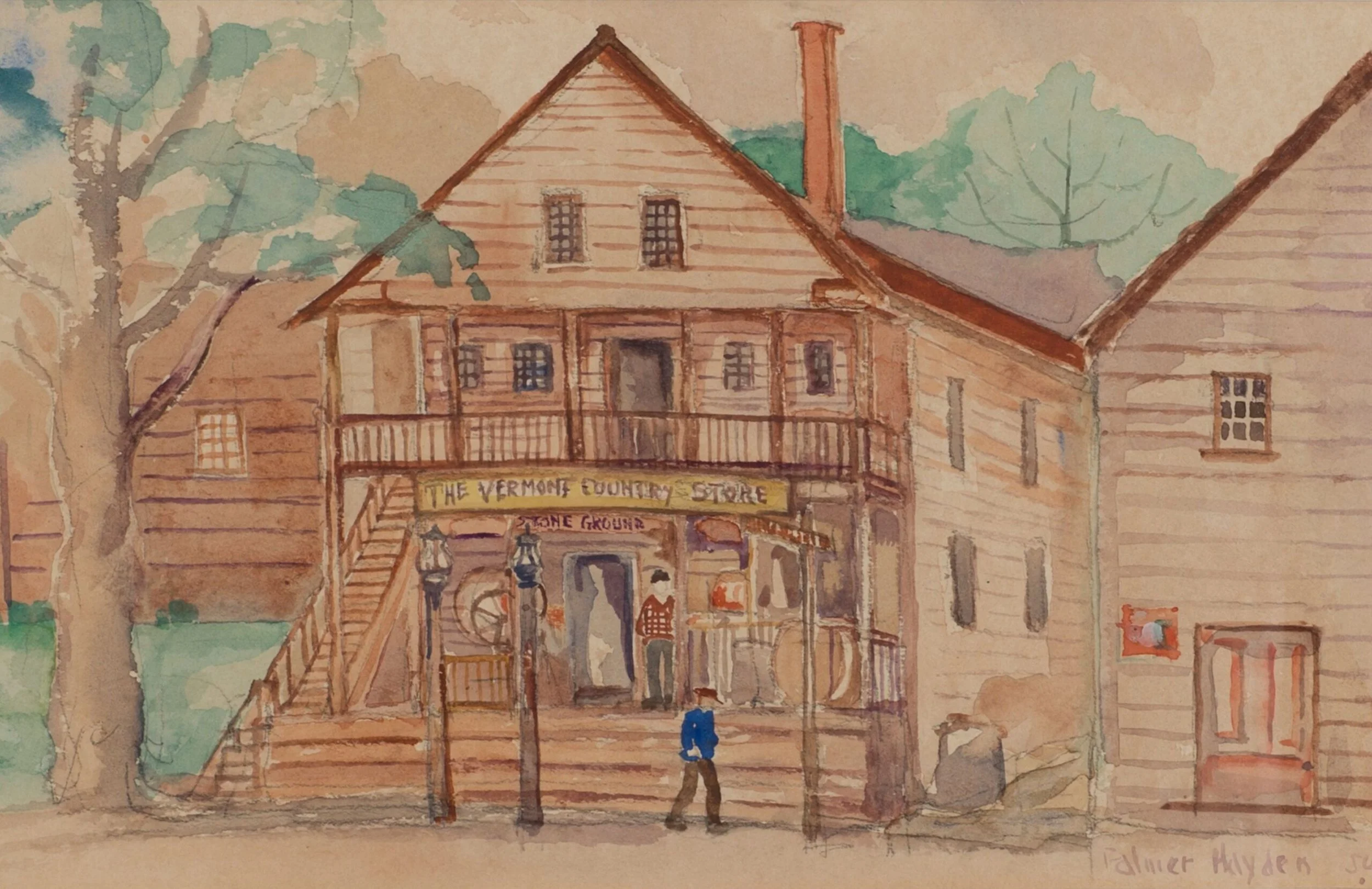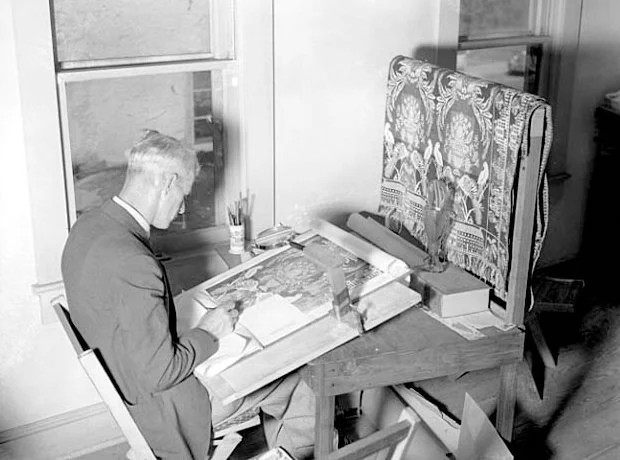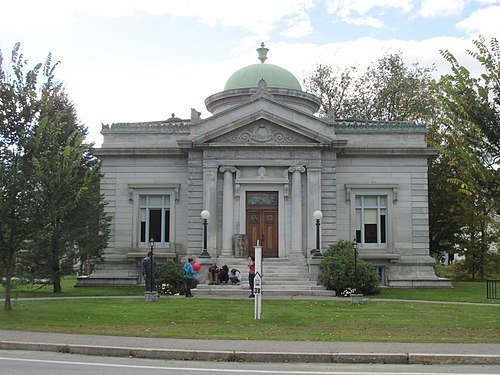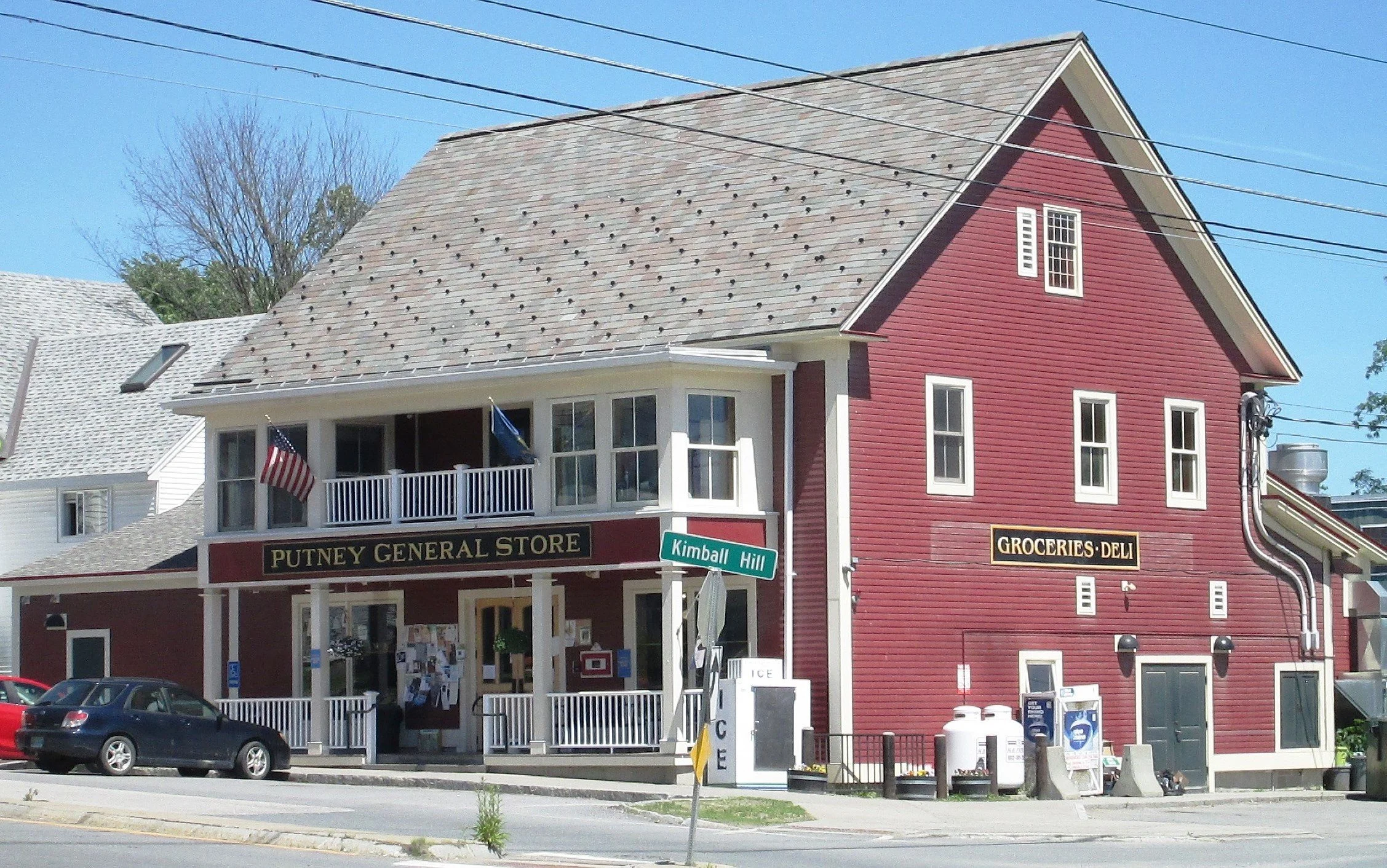
On an inland coast
The 1872 U.S. Coast Survey nautical chart/map of Burlington, Vt. It covers the urban center of Burlington as well as the surrounding areas as far south as Shelburn Point and as far north as as Rock Point. Offers exceptional detail, with important building, streets and property lines shown. In Lake Champlain there are countless depth soundings as well as notes on reefs and shoals.
Toward megalopolis on the ‘Vermonter’
“Southbound” (pastel), by Ann Wickham, in the show “White River Junction: A Pastel Perspective, ‘‘ at the Long River Gallery, White River Junction, Vt., through July 31.
Map of Amtrak’s “Vermonter” route
— by Jkan997
But I won't ask
Work by Barbara Kruger, in her show, through Dec. 1, at the Hall Art Foundation, Reading , Vt. She’s an American conceptual artist and collagist.
Jenne Farm, in Reading. It’s one of the most photographed farms in the world.
‘From the cellar stairs’
Union Village, in Thetford, Vt: Methodist church and defunct School House.
Photo by EdwardEMeyer
“I was happy, but I am now in possession of knowledge that this is wrong. Happiness isn't so bad for a woman. She gets fatter, she gets older, she could lie down, nuzzling a regiment of men and little kids, she could just die of the pleasure. But men are different, they have to own money, or they have to be famous, or everybody on the block has to look up to them from the cellar stairs.”
— Grace Paley (1922-2007), American writer. A native of New York City, she lived in Thetford, Vt., in her later years.
Thetford in 1912.
William T. Hall: Surviving the swarm
Text and watercolor painting by William T. Hall, a Florida-and-New England-based painter and writer
As we endured one of our family weeding sessions in our vegetable garden in Thetford, Vt., my grandfather said abruptly, and with strong emphasis, the four-letter “S-word”. It was enough of a surprise to lead grandmother to remind him that children were present. “Jesus, Mary and Joseph, Harold, your language – please!”
We all stared at Gramps as Grandmother looked over her glasses at my mother, who was smiling at her while fighting with a deep-set weed. Mother’s garden glove was full of a dozen or so vanquished weed specimens dropping dust as she looked over to me, rolling her eyes. I could see my reflection in her sunglasses as my little brother, Steve, leaned in and whispered to me , while wagging his index finger at the ground, “Naughty-naughty, Gramps”
“What’s wrong, Dad?” my mother asked. “You okay?”, she asked, as she pulled on another stubborn weed.
He said nothing as he set his jaw and unfolded his tall frame upward from his kneeling position like a camel standing up in the desert. He was looking at the top of his wrist as if to check a watch that wasn’t there. In that hand he held a big red Folger’s coffee can half-filled with kerosene into which he had been dropping hundreds of Japanese Beetles. These he had picked meticulously from the leaves of his potato plants. This sort of thing defined one of his methods for guarding against pests in the modern age of pesticides. “Better to pick’m off and get’m before they get you.”
After he had stood up fully, he looked perplexed, as if he didn’t believe what had just happened. He looked at my grandmother and said one word,
“Bee.”
“Sting?“ My mother asked.
“No he just scratched me a — warning”.
This we all knew from being on the farm. When you work around bees they are busy, too, gathering honey. Unless you create too much commotion around bees or otherwise make them too anxious, a human usually gets a (warning) a scratch before a (sting).
A warning was when a bee dragged his stinger across your skin to give you what felt like a little hot spark. A full “sting” was, of course, much more painful and was delivered with a bee’s ultimate strength, resulting in the hooked end of the stinger deep under the skin with the bee’s abdomen still attached to feed the stinger with venom. This added to your pain immensely. For this one extreme act, the honeybee pays with its life, and for allergic recipients, the sting can cause anaphylactic shock. To that person multiple stings all at once could cause death.
To my grandfather this “scratch” seemed like an unprovoked over-reaction, and he didn’t understand what he had done to deserve it.
Harold had been stung several times in his life but he understood that each time he’d done something provocative. When he saw that there were lots of other bees around us not harming us, it seemed as if nothing menacing had happened, so what was the big deal? Grandpa was insulted. He shook his head. My mother, teasing her father, asked him, “Dad, did you make a mistake? You know the difference between a Japanese beetle and a bee right”?
We all laughed and looked at my grandfather, wanting to gauge his reaction to my mother’s tease. He held the coffee can in one hand and laughed politely at the ribbing. He was always a good sport.
“I’m glad I didn’t sit on him”, he said and got a double-good laugh from all of us.
But as he was looking at us he was still wondering why there seemed to be so many bees everywhere in the air. They swirled like embers from a campfire. It was a busy confusion in orange, black and tan reminding him of when he attended his mother’s beehives at their turkey farm in Walpole, Mass., years before.
“Gramps! What’s is that?” asked my brother Steve he excitedly pointed to the sky above and behind Gramp’s silhouetted upper torso.
“Harold!” My grandmother shouted sharply, my grandfather and the sky above him reflecting in her glasses.…
Gramps looked at her perplexed as he turned to see what she meant. Something amazing and frightening was happening in the sky behind him. He had never seen anything like it before, and nor would he ever again. He looked back in awe at a jet-black roiling cloud in the sky over the Connecticut River. “It’s bees!”Then suddenly,“ SWARM!” he yelled as he set down his coffee can.
“What the heck!?” My mother exclaimed as she stood up, dropping her spade and the weeds from her gloves.
“Gloria, Quick help me up!” my grandmother yelled. My mother said frantically, in a commanding voice, to Steve and me, “Kids, get your grandmother up and head to the house”! As we helped our 200-pound grandmother to her feet, our mother rushed to her father’s side asking. “What should we do? Dad?”
They both looked up at the cloud and now we all could hear the sound of the bees, which mimicked the sound of a breeze blowing through tree leaves.
My grandfather mumbled something unintelligible in Swedish under his breath.
“Pop, in English!”, my mother asked in a slightly panicked tone. “What should we do?”
Without taking his eyes off the swarm, Gramp said, “Yes, get Lillian to the house, but don’t run, Ok? Just walk fast and don’t panic. We must not spook the swarm. Look at them! They look pretty riled alread.”
“Harold, you be careful,’’ my grandmother said.
“We’ll be fine, ’’ he said.
“Somewhere in the middle of the swirling mass is the Queen. Bees will do anything to protect their Queen. They’re looking for a new hive. These other bees down here are the scouts”.
Our farm was on the floor of Vermont’s Upper Connecticut River Valley about a football field’s length from the river and a mile’s south of the village center of Thetford. Our barn was in the middle of our property between two 25-acre fields, with two big shade-maple trees taller than any other trees next to the barn, which was four stories tall, from the basement to the peak of the open hayloft.
The whole barn structure was basically open. It was June, and the barn was empty of hay. There was one window in the peak and an open hay door in the end. The barn was designed to suck air in at the basement pig stalls on the backside of the building and to direct it inward and upward out through the big open barn doors and hay doors in both peaks. Those doors were 16 feet tall and were at the top of the earthen ramp that led to the second story. The ramp was designed for horses pulling full hay-wagons up into the big main hay-storage room. The main room was enormous, about 40 by 60 feet and 45 feet to the peak, where the hay trolley track and unloading-fork still hung covered in cobwebs.
Grandpa knew that the swarm of bees high in the air above our barn probably saw what looked like the perfect place for new beehive — a place with the perfect size and shape to house what seemed like a zillion tired and desperate bees and their queen.
My grandfather could see this in the few moments he had to scope out the problem and he understood that the welcome mat would be out until he could close up the barn to keep out these unwelcome guests.
Gramps now could hear the house windows being slammed down shut and the garage door being closed in the long shed off the main house. The ladies had done their job. The house would be a secure hiding place for the family no matter what happened in the other buildings. Grandpa’s carpentry shop, the hen house, a little stone milk-house and our barn were the only possible manmade homes for the bees.
The area directly above and behind the barn was a jet-black fuzzy moving mass. The swarm covered the whole width of the house, barn and shade trees. The scene reminded Gramps of the sand-and-soil clouds during the 1930’s Dust Bowl. Like those roiling clouds, the cloud of bees had a dark and menacing look.
Like a monster in the sky, the cloud seemed to lurch forward, north up the river, and then roll back on itself down the river as if there was dissension in the cloud of bees.
The air around us was still filled by a blizzard of bees, but even though we were occasionally scratched by the frantic scouting insects, we did not feel in danger. We could see their dilemma. We did not want to make their plight any worse than it was, but they could not have our barn, from which it would have taken months and lots of money to dislodge them. Worse, many bees would die in the removal. Maybe the bees could feel this, or maybe they were totally unaware of us, but they continued to leave us alone.
Gramps knew that with any flood of living things — humans, cattle, turkeys, fish and so on, only so many of them could get through a restricted opening at once without catastrophic results.
They had only their instinct to protect and nurture their queen. Each individual bee was devoted to its queen first, then secondly to the whole hive. Beyond that simple reality they had not evolved.
They were incapable of leaving her but confused about where to take her. At this point they seemed at a crossroads.
“Billy, go to the basement of the barn and close all the pig-pen doors down there,’’ Gramps told me. “Make sure the bees can’t get through any cracks. Throw hay at the bottom of the doors to close up the gap. Then meet me at the front ramp and we’ll close the big doors together. We can get to the windows last. Listen to me.…If this all turns bad, then get to the house and your mother will know what to do”.
“Where are you going, “ I asked.
“I’ll go to my shop and see if I can close it up. It’s wide open”.
“What about the chickens,” I asked.
“I don’t know? They eat bugs. They’ll have to fend for themselves”.
The cloud of bees was hanging over the rear pasture and getting closer to the barn by the minute, casting a dull shadow as when a cloud causes a shadow in the valley. I did get stung when I closed the last pig-pen door and I put my hand right on a bee. It hurt, but I sucked on the spot and kept moving.
When I got to the big doors in the front of the barn, grandfather was there. He’d rolled the burn-barrel up the ramp, saying that would be a last resort. He would start a smudge fire in the barrel to smoke out the incoming bees if it became necessary. The thought of any open fire in our barn made us both sick to think about. “Would you really risk that”, I asked my grandfather.
“No. I don’t think so, but we’ll see”.
As we rolled the barrel into place, something in the changing sky caused a shift on what had been sun-lit ground to scattered shadows there. With that change came a slight drop in temperature.
The moment seemed to signal something within the swarm. The bees moved. They roiled northward, and then suddenly their pace increased and they seemed to rise up farther. There was a bulge in the front of the cloud as it headed up river. The swarm passed over the iron bridge a half mile away at East Thetford and continued headed north, up the river. Where there had been millions of scouting bees at our farm, in a few minutes there were none.
The swarm eventually disappeared into far northwestern New Hampshire, where they were believed to have taken up residence in the stacked-up wrecked automobiles in a large junkyard abandoned years before, and then, finally, in spectacular Franconia Notch.
Little by little, one of those companies that catches and ships bees were able to capture many of the insects and transport them to areas of the U.S. that suffered from a deadly fungus that still endangers bee populations today.
Where the bees came from in such large numbers and why they took flight has never really been determined.
Characters
Painting by Peter R. Root, at Brandon Artists Guild, Brandon, Vt.
He says:
“Every new piece is an evolution of it’s predecessors and a continued exploration of scale, point of view and narrative. With the sculpture-paintings I’m using a sort of topographic mapping, an architect’s tool to describe a 3-dimensional plane and exploring the Cubist’s ideas about time and point of view relative to a static image. In these pieces, there is no single fixed point from where one takes in the whole picture. As one moves around the painting, in time, the fractured image varies and eventually coalesces only in the mind’s eye.’’
In downtown Brandon
Short-term housing
“Tiny House,’’ by Freeport, Maine-based Deanna Jacome, at the Southern Vermont Arts Center, Manchester, Vt., March 30-July. It’s in the center’s “Spring 2024 Solo Exhibition,’’ part of a longstanding tradition there. Multiple artists working in a variety of media, genres and styles are selected to show their work in rooms and spaces throughout the center’s Yester House.
Small, precious and laconic
Main Street in Danby, Vt.
— Photo by Redjar
Battery Park, overlooking the Burlington Waterfront and Lake Champlain
— Photo by Tania Dey
“All in all, Vermont is a jewel state, small but precious.”
— Pearl S. Buck (1892-1973), Nobel Prize-winning novelist. She lived in Danby, Vt.
xxx
“I don’t have a PR rep. I live in Vermont.”
Colin Trevorrow (born 1976), film director who has lived in Burlington. Vt.
Vector in Vermont
“Kites and Darts-7” ( mokuhanga collage, sumi and silver on handmade paper), by Underhill, Vt.-based artist Patty Hudak, in the group show “Dynamism’’, at Vermont Studio Center, in Johnson, through Jan. 25.
— Image courtesy of the artist.
The show features work by 10 artists who work in traditional forms and those who work in new media. Each artist explores their practice in different ways: from site-specific installations to vibrant abstract landscapes to digital imagery. All artists involved in this show are local to Vermont Studio Center and have studios on site.
Downtown Johnson in the college town’s brief but bucolic summer.
View of Underhill, Vt., and the famous ski mountain Mt. Mansfield, at 4,393 feet the state’s highest peak.
New N.H.-Vt. link to facilitate transfer of hydropower from Quebec to New England
Town center of Canaan, Vt.
—Photo by P199
Grange hall in Londonderry, N.H.
— Photo by Sdkb
Edited from a New England Council report
“National Grid has been awarded federal backing to construct the Twin States Clean Energy Link, a 1.2-gigawatt high-voltage direct current (HVDC) transmission line spanning from Canaan, Vt., to Londonderry, N.H.
This initiative, one of the Biden administration’s key energy-infrastructure projects, aims to facilitate the transfer of Quebec hydropower to New England and enable reciprocal energy exports. Anticipated to kick off in the latter half of 2026, the project is supported by a Department of Energy financing strategy, entailing the purchase of up to 50 percent capacity on eligible transmission lines to reduce risks and attract additional investment.
National Grid has garnered significant backing from local communities and stakeholders along the route, as it unveils plans for a $260 million community- benefits program alongside an expected $8.3 billion in wholesale energy cost savings over the initial twelve years of operation. The company operates as a multinational energy firm, separate from its regulated utilities, serving natural-gas and electricity consumers in New York and Massachusetts.
“‘This is an important step forward for the {two states} as we work to make the project a reality for the region,’ said Stephen Woerner, New England president of National Grid’s New England unit . ‘DOE has recognized the significant economic and environmental benefits of this project to New England communities, residents, and businesses, and we’re grateful for this recognition from our federal partners. This project would be a win for the New England region, and we thank our stakeholders and the many route communities for their strong support. We look forward to working with DOE on the next steps in the TFP process and continuing our deep engagement with the communities and our regional partners to bring this project to fruition.”’
But don’t go in
“Tower” (acrylic on canvas), by Peggy Wilson, in her show “Peggy Watson: Vermont Outdoors,’’ at the Northeast Kingdom Artisans Guild, St. Johnsbury, through Nov. 11.
Edited from a Wikipedia summary : In the mid-19th Century, St. Johnsbury became a minor manufacturing center, with the main products scales—the platform scale was invented there by Thaddeus Fairbanks, in 1830—and maple syrup and related products. With the arrival of the railroad line from Boston to Montreal in the 1850s, St. Johnsbury grew quickly and was named the shire town (county seat) in 1856, replacing Danville.
'The ‘landscape’ of my mind'
“Hairy Hare” (zinc etching and mixed media), by Dan Weldon, in his show “Dan Weldon: Solo 100, Oct, 21-Jan. 14, at Mitchell- Giddings Fine Arts, Brattleboro, Vt.
He says:
“I am an experimenter, explorer and a seeker of beauty. When I set out to work, there is no image in mind, but the vision unfolds as the work evolves. It usually begins with simple forms and marks with broad areas. It then becomes more refined and delicate and knits itself together through line.
”I am a process person, interested in employing materials and techniques to the ‘landscape’ of my mind. My drawings, paintings and prints evolve from the idea of linear pathways echoing from the tracks of animals in nature, fissures in rock palisades and the patterns created by my hands becoming ‘playful’ with my tools.
Learning to read a printing plate before inking, is like sensing the log before wielding the axe. So goes my act of creativity, being aware of what resonates in front of me and responding with marks, colors and textures. ‘‘
Downtown Brattleboro, as seen from a walking trail just across the Connecticut River, in New Hampshire, with the Green Mountains in the distance. There are many miles of scenic trails in and around the town, which has long been known as a arts center.
All-in-one retailing
“Vermont Country Store”(watercolor) Palmer Hayden (1890-1973), in the show “For the Love of Vermont,’’ at the Southern Vermont Arts Center, Manchester, Vt., through Nov. 5
All the world's a shadow box
Work by Melora Kennedy at The Front gallery, in Montpelier, Vt.
The gallery says:
“Melora Kennedy is a painter who has also made shadow boxes, and is currently occupied with still life. Still life makes it possible to practice her art a little every day—which makes it like meditation. Setting up a still life is similar to arranging the elements inside a shadow box: it resembles child's play. She's drawn in by the way that plants, in particular, express human emotion in their every gesture. She tries to paint so this feeling of liveliness comes across.’’
Melora has been living in Vermont since 1998. She teaches at a nursery school and lives with her partner on some land that they garden together.
'Lonely, happy child'
Newly emerged adult cicada
— Photo by Ollllonate
“Parents open their shutters and call
the lonely, happy child home.
The child who hates silences talks and talks
of cicadas and the manes of horses.’’
— From “All Summer Long,’’ by Carol Frost (born 1948) in Lowell, Mass. She has taught at the Vermont Studio Center, in Johnson, Vt.
All wet in the Green Mountain State
Work by Clinton, Mass.-based Peter Moriarty (born 1952) in the show “No Place Like Home,’’ at the BigTown Gallery, Rochester, Vt., through Oct. 29.
Civil War memorial in Rochester, Vt.
— Photo by Kenneth C. Zirkel
WPA art
"Skyscrapers” (circa 1937) (oil on canvas), by Joseph Stella (1877-1946), in the WPA Collection, at the T.W. Wood Gallery, Montpelier, Vt.
The Federal Art Project (1935-1943) was a New Deal program to fund America’s arts projects under the Works Progress Administration (WPA). It sustained some 10,000 artists during the Great Depression.
In 1940, Magnus Fossum, a WPA artist, copying the 1770 coverlet "Boston Town Pattern" for the WPA’s Index of American Design.
WPA Pump Station, in Scituate, Mass., built in 1938
Lessons from one-room schoolhouses
Outside a one-room schoolhouse in Norwich, Vt., about 1937
Back to School: Lessons from Norwich’s One-Room Schoolhouses is a new documentary film that explores the effort to preserve two remaining schoolhouses in Norwich, Vt.
Hear from the last generation of students who went to school there, and find out how the community uses these historic buildings today.
Back to School is part of Historic New England’s Everyone’s History series.
‘On a big expedition’
Shedd-Porter Memorial Library, in Alstead, N.H., was designed in the Beaux-Arts style by Boston architects William H. McLean and Albert H. Wright. It was built in 1910 as a gift from John Graves Shedd and Mary Roenna Porter in memory of their parents.
“The New England Thinkers
”Don't rush my sitting under the finch book tree. It has been dark for ten days and like two eyes feed one brain, we go driving. We are on an expedition to see the big numbers and wreckage of the floods.’’
— From the poem “The Continent Behind the College,’’ by Lesle Lewis
Ms. Lewis teaches at Landmark College (the college referred to), in Putney, Vt., and lives across the Connecticut River, in Alstead, N.H.
'I explore my secrets'
“Yearnings (4 men),’’ by Putney, Vt.-based sculptor Susan Wilson, at the Southern Vermont Arts Center, in Manchester, through May 7
She says in her artist statement:
“My work in clay has always been about seeking to understand my place in the world. With clay I explore my secrets, dreams, fears, hopes, and my questions. Using animal and figural images, I tell stories about being together and alone, about yearning for both connection and solitude, about dreaming and waiting, and about hoping for community.
“The three-dimensionality of clay enables me to create real spaces within and outside of which I can tell these stories. These stories float between and around the figures, charging the spaces with energy and unresolved tension.
“My most recent figurative work emerges from my retirement and move to a small and vibrant town {Putney} in Vermont and to a state full of energized people working together to build caring communities. I continue the yearnings for human connections and for a vibrant community as an antidote for all the pain and alienation in the present world. My work continues to be about waiting, hoping, yearning to find that community. I am making archetypal figures with slabs of clay. I am making hollow forms that continue to imply tangible interior space where the mystery and unanswered questions reside. I am exploring polarities such as interior and exterior, solitude and community. I use juxtapositions of scale to enliven and energize my forms and to invite questions.’’
Putney General Store, built 1840–1900
— Photo by Beyond My Ken
Putney is on the west side of the Connecticut River, above the mouth of Sacketts Brook. A falls on the brook provided water power for small early mills, and it was there that the main village was formed in the late 18th Century. But because the town did not have abundant sources of water power, it was largely bypassed by the Industrial Revolution of the mid-19th Century, and remained largely rural. Putney has numerous buildings in the Federal and Greek Revival styles popular during its most significant period of growth, the late 18th to mid-19th Century.
The Theophilus Crawford House, built about 1808 and considered an important example of the Federal style.


